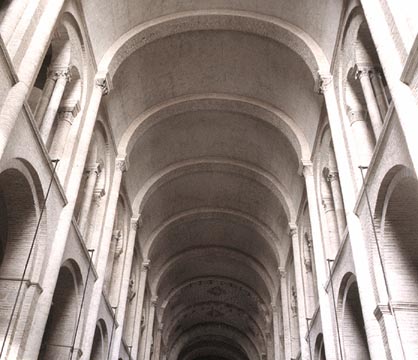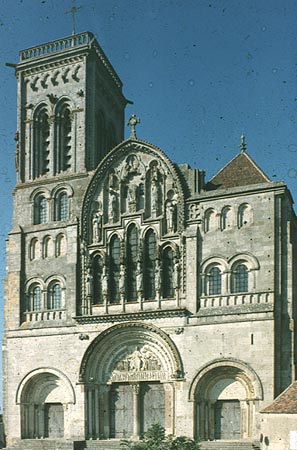Romanesque Synopsis:
Romanesque Art
Christian art received great support in the late Middle Ages. This period can
be divided into two periods: Romanesque (c.1050-1150) [c. 1050-1200, G11]
and Gothic (c. 1150-1400) [c. 1140-1500, G11]. Early Christian basilica
plan were improved with stone barrel or groin vaults supported with ribs and
butresses. Towers were added to the crossing and the west facade. The Abbey
Church of Sainte Foy exhibits these developments and the ambulatory, important
to display relics in a pilgrimage church. Focus is on the altar, but also upwards.
Painting emphasized the lives of the saints and was influenced by Byzantine
art, as in the Christ in Majesty painting in Tahull, Spain. Sculpture also decorated
medieval churches. The portal, including the tympanum, was one of the most imporant
areas for sculpture, as in the Last Judgment, from the Cathedral of Saint-Lazare,
France. Lively scenes in column capitals was another Romanesque sculptural development.
Independent sculpture, usually in the form of a devotional image, such as the
Throne of Wisdom, was commonly executed in painted wood. The re-introduction
of funerary art began at this time with tomb effigies. Book making remained
important, and embroidery, such as the Bayeux Tapestry became a new form of
narrative work.
Source:
http://www2.students.sbc.edu/hill00/seniorseminar/summary4.html
Romanesque Art
Romanesque Art 1050 - 1200
TERMS
Crusades
Facade
Trumeau - central columnar support in a main entrance
portal
Crossing tower
Mandorla
Gislebertus - sculptor of the "Last Judgement" tympanum
Romanesque
Pilgrimage
Tympanum
Archivolts
Compound piers
Incrustation
Baptistrey
Campanile - 'camp-a-neel-ya': bell tower
Reliquary - ornate box to hold relics
Quadrant vault - half barrel vault
Square Schematism - each nave bay measures exactly one-half and each square
in the aisles exactly one-quarter of a crossing square, and so on throughout
the building (G9-351)
Tribunes - upper galleries over inner aisles
Sedes Sapientiae or Throne of Wisdom - image popular in Romanesque art
SLIDES
 Nave (barrel)
vault -St. Sernin, Toulouse, France, Ca. 1070 - 1120
Nave (barrel)
vault -St. Sernin, Toulouse, France, Ca. 1070 - 1120
("The Angelus: Saint-Sernin by Dr. Marie-France Hilgar
http://www.sspx.ca/Angelus/2002_April/Saint-Sernin.htm)
Sant’ Ambrogio, Milan, Italy, late 11th cent. - early 12th cent.
West facade of St. Etienne, Caen, France, 1067- 1120
Nave, Durham Cathedral, England, c. 1093 - 1130
Cathedral (1063) Campanile (1174) and Baptistery (1153) of Pisa, Italy
Baptistery of San Giovanni, Florence, Italy, 1059
St. Pierre, Moissac, France
Christ in Majesty with angels & 24 Elders, tympanum, south portal, 16’
6” diameter, c. 1115-35
Old Testament Prophet trumeau of the south portal, 1115 - 30
St. Lazare at Autun, France c. 1120 - 1135
Last Judgment, by Gislebertus, west tympanum, 11’4” x 21”
 La Madeleine,
Vezelay, France
La Madeleine,
Vezelay, France
The Ascension of Christ and Mission of the Apostles, tympanum of the central
portal of the narthex, c. 1120 - 32
Moses Expounding the Law, Bury Bible, Master Hugo, 1’ 8” x 1’
2”, ca. 1135
Bayeux Tapestry, Embroidery wool on linen, Bayeux, France c. 1070 - 80
Links:
IMAGES OF MEDIEVAL ART AND ARCHITECTURE
by Alison Stones
http://www.pitt.edu/~medart/index.html
Romanesque Images
http://employees.oneonta.edu/farberas/arth/arth109/arth109_sl19.html
Art of the Crusades Era
http://www.umich.edu/~eng415/topics/art/art-article.html
Online Reference Book for Medieval Studies
http://orb.rhodes.edu/
European Art: Veneration of the Virgin
("Virgin and Child Enthroned")
http://www.dia.org/collections/euroart/virgin/30.383.html
DJB Quick Notes:
~ St. Matthew: Angel
~ St. John: Eagle
~ St. Luke: Ox
~ St. Mark: Lion
DJB In-Depth Notes:
~ "Romanesque" is specifically an art
historical designation referring to stylistic treatments through Europe in the
same period: it describes Medieval art that shares similarites with Ancient
Rome, including -
~ this massive building trend was based on several
factors, the need to house relics which would be visited by many pilgrims, possible
relief and gratitude having passed through millenium year, and increased wealth
of church and regions to showcase and consolidate presence and authority
 Nave (barrel)
vault -St. Sernin, Toulouse, France, Ca. 1070 - 1120
Nave (barrel)
vault -St. Sernin, Toulouse, France, Ca. 1070 - 1120 La Madeleine,
Vezelay, France
La Madeleine,
Vezelay, France